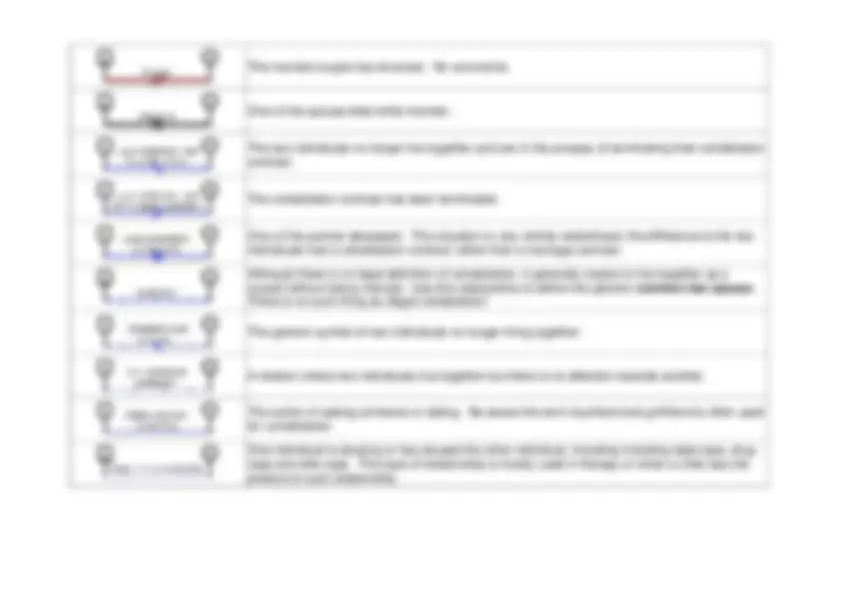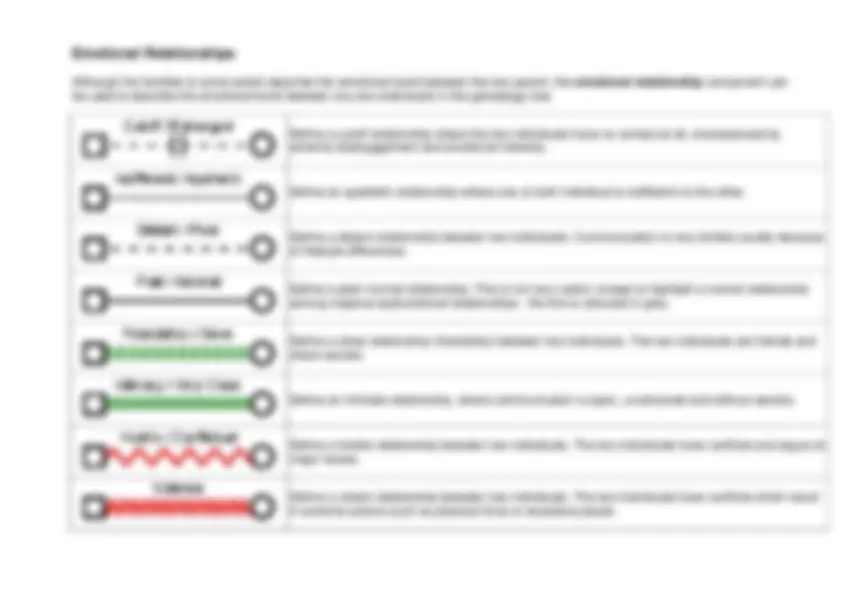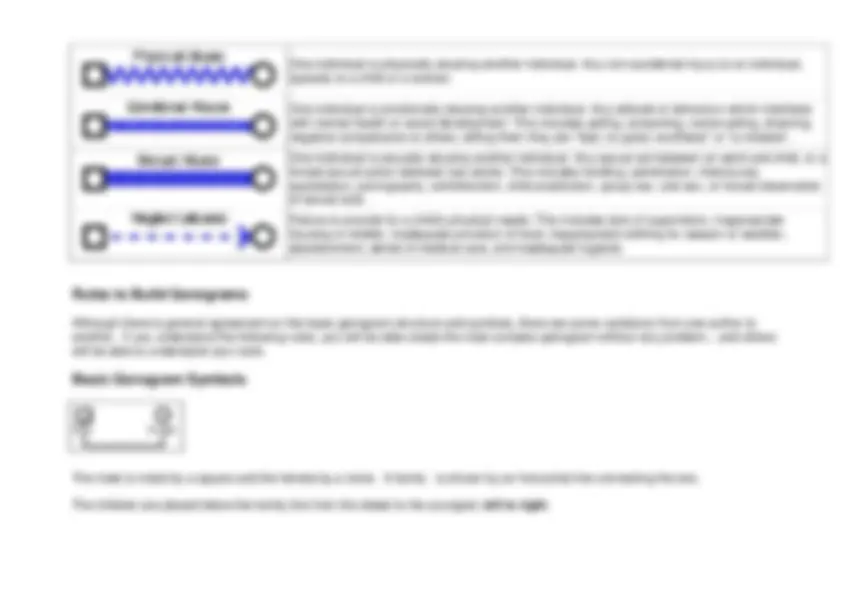





Study with the several resources on Docsity

Earn points by helping other students or get them with a premium plan


Prepare for your exams
Study with the several resources on Docsity

Earn points to download
Earn points by helping other students or get them with a premium plan
Community
Ask the community for help and clear up your study doubts
Discover the best universities in your country according to Docsity users
Free resources
Download our free guides on studying techniques, anxiety management strategies, and thesis advice from Docsity tutors
An overview of genogram symbols and rules for representing family relationships and emotional bonds. It covers the representation of males, females, children, family relationships, and emotional relationships using various symbols. The document also explains the rules for building genograms, including the placement of males, females, spouses, and children.
What you will learn
Typology: Schemes and Mind Maps
1 / 7

This page cannot be seen from the preview
Don't miss anything!




In a genogram, the male is represented by a square on the left and the female by a circle on the right
Standard gender symbols for a genogram
In a standard genogram, there are three different type of children: biological/natural child, adopted child and foster child. A triangle is used to represent a pregnancy, miscarriage and abortion. In the case of a miscarriage, a diagonal cross to indicate the death of the fetus is drawn on top of the triangle. The abortion is displayed similar to the miscarriage with an additional horizontal line. A still birth is displayed the same as its gender, however the gender symbol is twice as small while the diagonal cross remains the same size.
Genogram symbols for child links and special birth
The child links are joined together for multiple births such as twins, triplets, quadruplets etc.Identical twins (or triplets ...) are displayed by an horizontal line between the siblings. In the example below, the mother got two fraternal twin brothers, two identical twin sisters and triplets, which one died at birth.
Child links are joined for multiple births such as twins and triplets
The next genogram component is the family relationship to describe the union of two individuals If you are confused, you may replace family relationship by marriage as long as you understand that marriage
is a special case of a family relationship. Other family relationships are divorce, separation, cohabitation, engagement, etc
This family relationship represents a married couple. There is no special symbol to distinguish a civil marriage and/or a religious marriage.
This is the generic symbol to describe a married couple no longer living together. A separation is displayed by a single oblique bar.
The married couple is separated and started legal procedure for an eventual divorce..
Although the families to some extent describe the emotional bond between the two parent, the emotional relationship component can be used to describe the emotional bond between any two individuals in the genealogy tree
Define a cutoff relationship where the two individuals have no contact at all, characterized by extreme disengagement and emotional intensity.
Define an apathetic relationship where one or both individual is indifferent to the other.
Define a distant relationship between two individuals. Communication is very limited usually because of lifestyle differences.
Define a plain normal relationship. This is not very useful, except to highlight a normal relationship among massive dysfunctional relationships. the line is coloured in grey.
Define a close relationship (friendship) between two individuals. The two individuals are friends and share secrets.
Define an intimate relationship, where communication is open, uncensored and without secrets.
Define a hostile relationship between two individuals. The two individuals have conflicts and argue on major issues.
Define a violent relationship between two individuals. The two individuals have conflicts which result in extreme actions such as physical force or excessive power.
One individual is physically abusing another individual. Any non-accidental injury to an individual, typically to a child or a woman.
One individual is emotionally abusing another individual. Any attitude or behaviour which interferes with mental health or social development. This includes yelling, screaming, name-calling, shaming, negative comparisons to others, telling them they are "bad, no good, worthless" or "a mistake". One individual is sexually abusing another individual. Any sexual act between an adult and child, or a forced sexual action between two adults. This includes fondling, penetration, intercourse, exploitation, pornography, exhibitionism, child prostitution, group sex, oral sex, or forced observation of sexual acts. Failure to provide for a child's physical needs. This includes lack of supervision, inappropriate housing or shelter, inadequate provision of food, inappropriate clothing for season or weather, abandonment, denial of medical care, and inadequate hygiene.
Although there is general agreement on the basic genogram structure and symbols, there are some variations from one author to another. If you understand the following rules, you will be able create the most complex genogram without any problem... and others will be able to understand your work.
The male is noted by a square and the female by a circle. A family is shown by an horizontal line connecting the two.
The children are placed below the family line from the oldest to the youngest, left to right.
The second scenario is the same as the first one, except the spouse had three husbands. She had three children with her first husband and divorced. The wife married another man, had one child with him and now lives with someone else. Please notice the oldest child is always at the left most position of the family of his biological parents. In this scenario, the "Oldest Brother" is older than the twins and the half sister, however the half-sister must be placed under the family of her biological parents. Since the second marriage is after the first marriage, it follows that the half sister is younger than the children from the first marriage. The half sister therefore appears to the left, although she is not the oldest child. If you are confused, please read this paragraph again.
In summary, here are the four rules to build a genogram: